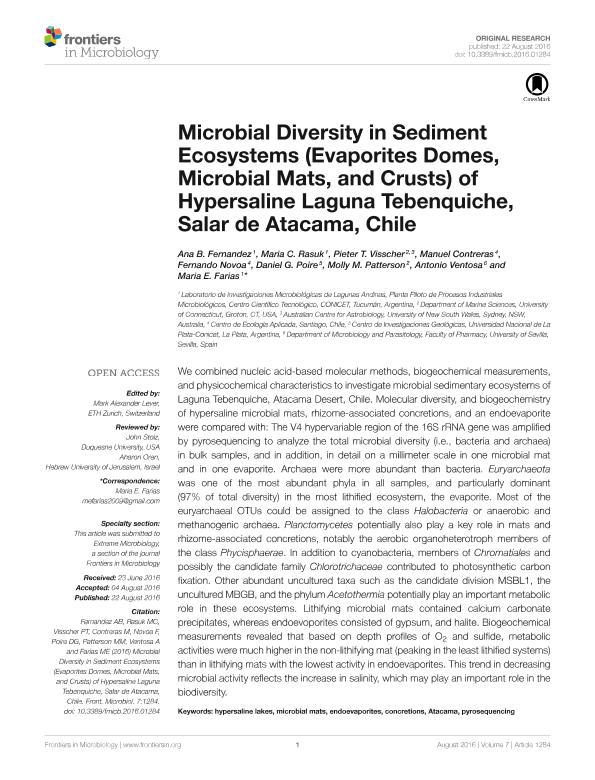Mostrar el registro sencillo del ítem
dc.contributor.author
Fernandez Gonzalez, Ana Beatriz

dc.contributor.author
Rasuk, Maria Cecilia

dc.contributor.author
Visscher, Pieter T.
dc.contributor.author
Contreras, Manuel
dc.contributor.author
Novoa, Fernando
dc.contributor.author
Poire, Daniel Gustavo

dc.contributor.author
Patterson, Molly M.
dc.contributor.author
Ventosa, Antonio
dc.contributor.author
Farias, Maria Eugenia

dc.date.available
2018-03-02T21:14:23Z
dc.date.issued
2016-08
dc.identifier.citation
Fernandez Gonzalez, Ana Beatriz; Rasuk, Maria Cecilia; Visscher, Pieter T.; Contreras, Manuel; Novoa, Fernando; et al.; Microbial diversity in sediment ecosystems (evaporites domes, microbial mats, and crusts) of Hypersaline Laguna Tebenquiche, Salar de Atacama, Chile; Frontiers; Frontiers in Microbiology; 7; AUG; 8-2016; 1-18
dc.identifier.issn
1664-302X
dc.identifier.uri
http://hdl.handle.net/11336/37770
dc.description.abstract
We combined nucleic acid-based molecular methods, biogeochemical measurements, and physicochemical characteristics to investigate microbial sedimentary ecosystems of Laguna Tebenquiche, Atacama Desert, Chile. Molecular diversity, and biogeochemistry of hypersaline microbial mats, rhizome-associated concretions, and an endoevaporite were compared with: The V4 hypervariable region of the 16S rRNA gene was amplified by pyrosequencing to analyze the total microbial diversity (i.e., bacteria and archaea) in bulk samples, and in addition, in detail on a millimeter scale in one microbial mat and in one evaporite. Archaea were more abundant than bacteria. Euryarchaeota was one of the most abundant phyla in all samples, and particularly dominant (97% of total diversity) in the most lithified ecosystem, the evaporite. Most of the euryarchaeal OTUs could be assigned to the class Halobacteria or anaerobic and methanogenic archaea. Planctomycetes potentially also play a key role in mats and rhizome-associated concretions, notably the aerobic organoheterotroph members of the class Phycisphaerae. In addition to cyanobacteria, members of Chromatiales and possibly the candidate family Chlorotrichaceae contributed to photosynthetic carbon fixation. Other abundant uncultured taxa such as the candidate division MSBL1, the uncultured MBGB, and the phylum Acetothermia potentially play an important metabolic role in these ecosystems. Lithifying microbial mats contained calcium carbonate precipitates, whereas endoevoporites consisted of gypsum, and halite. Biogeochemical measurements revealed that based on depth profiles of O2 and sulfide, metabolic activities were much higher in the non-lithifying mat (peaking in the least lithified systems) than in lithifying mats with the lowest activity in endoevaporites. This trend in decreasing microbial activity reflects the increase in salinity, which may play an important role in the biodiversity.
dc.format
application/pdf
dc.language.iso
eng
dc.publisher
Frontiers

dc.rights
info:eu-repo/semantics/openAccess
dc.rights.uri
https://creativecommons.org/licenses/by-nc-sa/2.5/ar/
dc.subject
Atacama
dc.subject
Concretions
dc.subject
Endoevaporites
dc.subject
Hypersaline Lakes
dc.subject
Microbial Mats
dc.subject
Pyrosequencing
dc.subject.classification
Otras Ciencias Biológicas

dc.subject.classification
Ciencias Biológicas

dc.subject.classification
CIENCIAS NATURALES Y EXACTAS

dc.title
Microbial diversity in sediment ecosystems (evaporites domes, microbial mats, and crusts) of Hypersaline Laguna Tebenquiche, Salar de Atacama, Chile
dc.type
info:eu-repo/semantics/article
dc.type
info:ar-repo/semantics/artículo
dc.type
info:eu-repo/semantics/publishedVersion
dc.date.updated
2018-03-02T15:11:12Z
dc.journal.volume
7
dc.journal.number
AUG
dc.journal.pagination
1-18
dc.journal.pais
Suiza

dc.journal.ciudad
Lausanne
dc.description.fil
Fil: Fernandez Gonzalez, Ana Beatriz. Consejo Nacional de Investigaciones Científicas y Técnicas. Centro Científico Tecnológico Conicet - Tucuman. Planta Piloto de Procesos Industriales Microbiologicos; Argentina
dc.description.fil
Fil: Rasuk, Maria Cecilia. Consejo Nacional de Investigaciones Científicas y Técnicas. Centro Científico Tecnológico Conicet - Tucuman. Planta Piloto de Procesos Industriales Microbiologicos; Argentina
dc.description.fil
Fil: Visscher, Pieter T.. University of Connecticut; Estados Unidos. University of New South Wales; Australia
dc.description.fil
Fil: Contreras, Manuel. Centro de Ecología Aplicada; Chile
dc.description.fil
Fil: Novoa, Fernando. Centro de Ecología Aplicada; Chile
dc.description.fil
Fil: Poire, Daniel Gustavo. Consejo Nacional de Investigaciones Científicas y Técnicas. Centro Científico Tecnológico Conicet - La Plata. Centro de Investigaciones Geológicas. Universidad Nacional de La Plata. Facultad de Ciencias Naturales y Museo. Centro de Investigaciones Geológicas; Argentina
dc.description.fil
Fil: Patterson, Molly M.. University of Connecticut; Estados Unidos
dc.description.fil
Fil: Ventosa, Antonio. Universidad de Sevilla; España
dc.description.fil
Fil: Farias, Maria Eugenia. Consejo Nacional de Investigaciones Científicas y Técnicas. Centro Científico Tecnológico Conicet - Tucuman. Planta Piloto de Procesos Industriales Microbiologicos; Argentina
dc.journal.title
Frontiers in Microbiology
dc.relation.alternativeid
info:eu-repo/semantics/altIdentifier/doi/http://dx.doi.org/10.3389/fmicb.2016.01284
dc.relation.alternativeid
info:eu-repo/semantics/altIdentifier/url/https://www.frontiersin.org/articles/10.3389/fmicb.2016.01284/full
Archivos asociados
